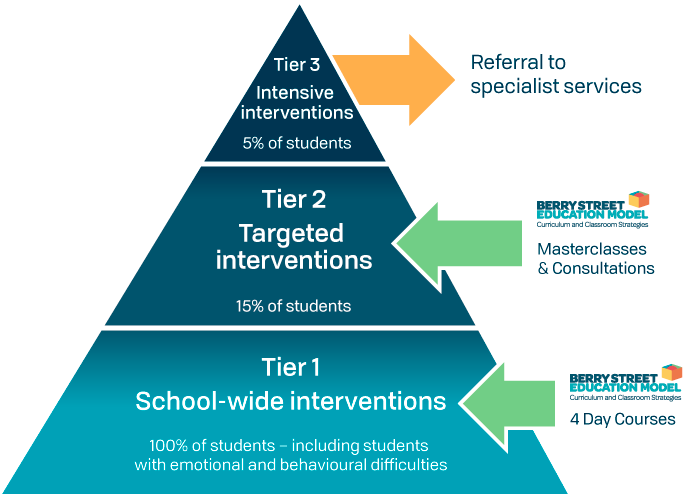This article considers how BSEM can be ‘the link’ that allows particular frameworks and programs to work in harmony and achieve a school’s teaching and learning goals over the long term. We hope that it will assist teachers and school leaders when formulating their whole school strategic planning and their annual implementation planning.
Berry Street has provided a missing link to RRRR, SWPBS, Kids Matter & Restorative Practices
This feedback from a participant who recently completed BSEM training really got us thinking about how we can further support schools to understand how BSEM can fit within an improvement planning process. It also highlighted how BSEM can help make sense of the varied initiatives, programs and approaches that schools are called upon to deliver in their settings.
We know that schools want to be across the recent research around how to provide the best possible education for young people. They also want this knowledge to translate into best practice in their classrooms and across their school setting.
We know this because the BSEM team are working in school communities who are engaged with these ideas; we are in awe of the effort and determination of our educators to do the very best for students. However, we also know that educators work hard and there is never quite enough time in the day! At times it can feel overwhelming when another new initiative, approach or piece of ‘expert advice’ comes our way.
BSEM is not an ‘add on’; it is a ‘how to’
The Berry Street Education Model has been built around proven positive education, trauma-informed and wellbeing practices, so schools can rest assured that any evidence-based approaches for school improvement will be entirely congruent with BSEM.
BSEM is designed to enable students’ academic and personal growth, and to complement a school’s teaching and learning framework over the long term. BSEM provides schools with the training, curriculum and strategies to engage even the most challenging students, so any new initiatives or programs can be delivered through BSEM.
School Wide Positive Behaviour Support (SWPBS)
If we look at the School Wide Positive Behaviour Support Pyramid, we can see that BSEM strategies map completely to Tier 1 interventions which are universal and target 100% of students (School-Wide Positive Behaviour Support: An Introduction for School Principals, 2019). If a school engages with the BSEM strategies from each of the domains, then they are already well on the way to evidencing their alignment with the SWPBS model.
It’s important to keep in mind that the success of SWPBS for school improvement is grounded on effective Tier 1 interventions – it’s clear that BSEM is of value here. But BSEM also offers specialised support through our masterclasses and consultations, for students who will benefit from Tier 2 interventions.

Zones of Regulation
The Zones of Regulation (Kuyper, 2019) is a tool that many schools use to assist students to understand their stress response and learn self-regulation.
Several schools we have worked with have taken our ‘Ready to Learn Scales’ and mapped them to the Zones.
Our ‘Ready to Learn Plans’ are another example of how the strategies from Day 1 of the BSEM training, BODY, align to the Zones of Regulation.
Victorian Framework for Improving School Outcomes (FISO)
If we consider FISO, the Victorian Department of Education’s Framework for improving School Outcomes (Strategic Planning: Improving School Governance, 2019) and the Respectful Relationships (Respectful Relationships, 2019) initiative, we can see that BSEM and Respectful Relationships contribute to different aspects of the Framework.
However, BSEM and Respectful Relationships both contribute to building the values and culture of a school community so they can work together to create safe, respectful and positive school environments that all young people can thrive within.
High Impact Teaching Strategies
The below outlines how our five domains (Body, Relationship, Stamina, Engagement and Character) align with the High Impact Teaching Strategies (HITS).
BSEM Strategies – Mapped to HITS
Explicit Teaching
Whole School Relationships/Approach
SEL (Social and Emotional Learning)
All domains: Body – Relationship – Stamina – Engagement – Character
Structuring Lessons
Consistent predictable routines (morning circle/greetings – De-escalation – Self-regulation – Flow – Stamina for independent learning – Self-regulation – Positive emotion – Cultivating wonder – Play, humour and fun – Reflection (WWW – what went well)
Setting goals
Consistent predictable routines – Present, centred, ready to learn – Attachment – Willingness – Emotional intelligence – Stamina for independent learning – Values – Hope
Worked examples
Flow – Process praise – Growth mindset – Hope – Resilience
Collaborative learning
Self-regulation – Emotional intelligence – Values – Character strength – Community strengths – Resilience – Positive emotions
Multiple exposures
Consistent predictable routines – Positive praise – Resilience – Hope
Questions
Flow – Active constructive responding – Gratitude
Feedback
Unconditional positive regard – Attachment – Positive narration – Golden statements – Person praise – Values – Resilience – Gratitude
Differentiated teaching
De-escalation – Mindfulness – Positive movement and rhythm – Present, centred, ready to learn – Redefining power – Stamina for independent learning
Meta-cognitive strategies
Teaching students to think about their own thinking. All domains: Body – Relationship – Stamina – Engagement – Character
For example, Feedback is an effective teaching strategy because it is a demonstration of care from the teacher. Feedback is a relational strategy and BSEM takes the importance of having relational classrooms very seriously, as the best teaching and learning takes place within strong, attached teacher-student relationships. Similarly, Questioning is a way to use those strong relationships with young people to boost engagement and therefore improve learning.
Structuring lessons and Setting goals are strategies that help create the routine rich, predictable learning environment that young people, particularly trauma-affected young people, flourish within. Explicit Teaching is the bread and butter of BSEM, all the strategies we use with our young people are explicitly taught. Knowledge is power, understanding ourselves is the first step to self-improvement. Real learning only occurs when a young person understands what we are trying to achieve with them and is ready and willing to enter into the collaborative effort.
This article just touches the surface of our thinking in this area, but we hope that we’ve shown how BSEM as an approach sits in alignment with other school improvement frameworks. Our aim is to provide the training, curriculum and practical strategies that can assist schools in achieving their teaching and learning goals.
We would love to know your thoughts! Please get in touch if you would like to engage in further discussions.
Kuypers, L. (2019, September 15). The Zones of Regulation. Retrieved from
https://zonesofregulation.com/
State of Victoria (Department of Education and Training). (2019, September 15). Respectful Relationships. https://www.vic.gov.au/respectful-relationships
State of Victoria (Department of Education and Training). (2019, September 15). School-wide Positive Behaviour Support: An introduction for school Principals.
State of Victoria (Department of Education and Training). (2019, September 15). Strategic Planning: Improving School Governance.

Senior Manager Training and Quality
Master of Special and Inclusive Education (Emotional Disturbance/Behavioural Problems) | Graduate Diploma Secondary Education | Bachelor Youth Studies | Diploma Community Services (Youth Work) | Diploma Performing Arts | Certificate IV Training and Assessment



